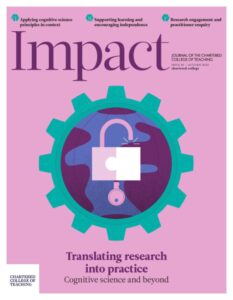Exploring the use of simulation in a primary ITE context

Kirstin Mulholland and Carl Luke, Lecturers in Education, Northumbria University, UK
Sophie Meller, David Nichol, Arlene Anderson and Deborah Herridge, Senior Lecturers in Education, Northumbria University, UK
William Gray, Teacher, The Grove Primary School, UK
When educating future teachers in higher education contexts, there is often a perceived divide between theoretical and professional knowledge (McGarr et al., 2017). One potential means of bridging the gap between theory and practice is through using simulation. Simulation aims to replicate the interplay between the knowledge, skills and attitudes necessary in real-life situations. It has been found to improve student engagement across professional fields, including social work (Meredith et al., 2021), health (Platt et al., 2021) and, more recently, teacher education (Kaufman and Ireland, 2019).
Through providing an authentic context for difficult-to-teach concepts, simulation can offer a ‘safe space’ in which to explore the complex decisions that teachers must make (Ferry et al., 2004), and is associated with improved self-confidence and feelings of preparedness (McGarr, 2021). We therefore developed a simulated Year 2 cohort, consisting of realistic pupil profiles, attendance and attainment data, histories, specialist reports and school policies. Each simulation centred around a distinct scenario – for example, developing a support plan for Oscar, a fictional child with special educational needs.
However, research suggests that simulation presents a complex form of learning, leading to high cognitive load, which can lessen its effectiveness (Fraser et al., 2015; Sun et al., 2017). Upon first developing simulations to complement our postgraduate teacher education programmes, this issue was highlighted in one student’s observation that ‘Some of the challenges were that it was overwhelming. Loved it and the information but overwhelming to wrap my head around.’ For our staff team, this prompted considerable reflection regarding how best to incorporate simulations into our ITE provision while effectively managing cognitive load.
Drawing from the work of Reedy (2015), this reflective piece shares some of the ways in which cognitive load theoryAbbreviated to CLT, the idea that working memory is limited ... More informed the design of our subsequent simulations. This includes considering students’ prior experiences and cognitive schemas; adopting a staged approach to allow for reflection and debriefing; and the use of tutors as ‘plants’ during the session, to support learning and reduce extraneous load.
Working with schemas
‘Humans are able to maintain and encode slightly more information if we can make sense of it as we take it in; if existing cognitive schema are in place to support the sensory input.’ (Reedy, 2015, p. 356) Simulation sessions were carefully timed and sequenced, appreciating students’ prior learning experiences, to ensure that they had adequate schemas into which to assimilate and accommodate new knowledge (Kirschner and Hendrick, 2020).
Although some students suggested that it would have been helpful to experience these simulations before embarking on their first placement, their lack of schemas at that point may have reduced their ability to engage with the learning content (Chi et al., 1982; Reedy, 2015; Kirschner and Hendrick, 2020). Instead, our simulations took place halfway through the academic year, allowing student teachers to draw from previous placement experiences. The content and focus of simulations were designed to build upon existing cognitive schemas relating to assessment data, working with pupils with SEND and communicating with parents.
Adopting a ‘staged’ approach
Each simulation adopted a staged approach, which enabled reflection between sessions (Moon, 1999) prior to the introduction of more complex scenarios. Prior to the simulation, a brief outline of the focus, together with supporting documents, was shared with students. This allowed them to familiarise themselves with key theories and information, thus lessening extraneous cognitive load (Reedy, 2015). Each simulation also utilised a multi-part structure, consisting of ‘live’ face-to-face input, interspersed with opportunities for directed learning tasks. Using formative assessment information gathered throughout the ‘live’ elements of the simulations, tutors were able to adapt content to meet students’ learning needs, address misconceptions and give rapid feedback.
Goal-free tasks, with multiple possible responses and solutions, were incorporated into the simulation design, increasing student success and reducing the cognitive load associated with the need to find specific pre-determined answers (Reedy, 2015). When first reviewing simulation documentation, open questions such as ‘What do you notice?’ were used to allow students to develop several possible appropriate responses. Students were encouraged to work collaboratively within study groups to facilitate the sharing and co-construction of ideas, while also supporting them to effectively manage cognitive load (Nihalani and Robinson, 2022). Collaborative tasks included working together to undertake data analysis, and the shared drafting of ‘paperwork’ associated with the simulations – for instance, a support plan for a child with SEND.
The fidelity – or realism – of the simulation was informed by students’ existing knowledge and practical experience. Extraneous cognitive load was reduced through delivering sessions within a familiar location on campus, providing a ‘safe space’ for the exploration of potentially challenging ideas and concepts. When designing the simulation scenarios, only the information required to understand the learning focus was given. This consciously reduced any additional information, which served only to increase authenticity or fidelity. Furthermore, the simulations offered idealised scenarios, without emergency or particularly surprising situations. This was a deliberate strategy; while more complex scenarios do occur in practice, they are less appropriate as learning tasks due to the high cognitive demands for student teachers at this point in their training (Reedy, 2015).
The use of tutors as ‘plants’
Drawing on the ideas of Nestel et al. (2014), tutors with an understanding of students’ previous learning experiences were used as ‘plants’ to support learning and reduce unnecessary extraneous cognitive load. During the simulations, as plants, tutors offered additional support by signposting key information, referencing previous relevant experiences and suggesting possible next steps. This increased student success through concentrating effort on the focus task (Reedy, 2015), enabling tutors to guide students through the simulation experiences, adjusting the complexity of tasks for those with different levels of experience.
Concluding thoughts
While our own experiences support the work of Kaufman and Ireland (2019) in suggesting the potential benefits of incorporating simulation into teacher education programmes, given the association of this pedagogic approach with high cognitive load, it is clear that ways of managing these demands need to be explored. This reflective piece highlights aspects of our simulation design that were implemented to effectively manage cognitive load and promote learning and engagement through this innovative approach.
We believe that, through careful consideration of students’ prior experiences and cognitive schemas, adopting a staged approach to allow for reflection and debriefing, and the use of tutors as ‘plants’, it is possible to maintain appropriate levels of cognitive load to maximise learning. Indeed, we believe that by using simulations in this way, we can continue to better support professional learning for student teachers. Furthermore, we suggest that simulation offers a powerful vehicle not only to support those colleagues who are new to the profession, but also as a means of providing ongoing support for teachers throughout their careers.
- Chi MTH, Glaser R and Rees ER (1982) Expertise in problem solving. In: Sternberg RS (ed) Advances in the Psychology of Human Intelligence, vol 1. Hillsdale, NJ: Erlbaum, pp. 1–75.
- Ferry B, Kervin L, Cambourne B et al. (2004) Online classroom simulation: The next wave for pre-service teacher education. In: Beyond the comfort zone: Proceedings of the 21st ASCILITE Conference, Perth, Australia, 5–8 December 2004, pp. 294–302. Perth: Australian Society for Computers in Learning in Tertiary Education.
- Fraser KL, Ayres P and Sweller J (2015) Cognitive load theory for the design of medical simulations. Simulation in Healthcare 10(5): 295–307.
- Kirschner P and Hendrick C (2020) How Learning Happens. Oxon: Routledge.
- McGarr O (2021) The use of virtual simulations in teacher education to develop pre-service teachers’ behaviour and classroom management skills: Implications for reflective practice. Journal of Education for Teaching 47(2): 274–286.
- McGarr O, O’Grady E and Guilfoyle L (2017) Exploring the theory–practice gap in initial teacher education: Moving beyond questions of relevance to issues of power and authority. Journal of Education for Teaching 43(1): 48–60.
- Meredith C, Heslop P and Dodds C (2022) Simulation: Social work education in a third place. Social Work Education. DOI: 10.1080/02615479.2021.1991908.
- Moon JA (1999) Reflection in Learning & Professional Development: Theory & Practice. Sterling, VA: Stylus Publishing.
- Nestel D, Mobley BL Hunt EA et al. (2014) Confederates in health care simulations: Not as simple as it seems. Clinical Simulation in Nursing 10(12): 611–616.
- Nihalani PK and Robinson DH (2022) Balancing collaboration and cognitive load to optimize individual and group desirable difficulties. Journal of Educational Computing Research 60(2): 433–454.
- Platt A, McMeekin P and Prescott-Clements L (2021) Effects of the simulation using team deliberate practice (Sim-TDP) model on the performance of undergraduate nursing students. BMJ Simulation and Technology Enhanced Learning 7(2): 66–74.
- Reedy GB (2015) Using cognitive load theory to inform simulation design and practice. Clinical Simulation in Nursing 11(8): 355–360.
- Sun NZ, Anand PA and Snell L (2017) Optimizing the design of high-fidelity simulation-based training activities using cognitive load theory – lessons learned from a real-life experience. Journal of Simulation 11(2): 151–158.
About the Author
In 2021 Carl was seconded to Northumbria University from a local primary school in the Northumbria ITT partnership. Carl was a class teacher, curriculum leader, Primary Science Teaching Trust (PSTT) fellow and Specialist Leader of Education for the Ouseburn Learning Trust.
-
This author does not have any more posts.











